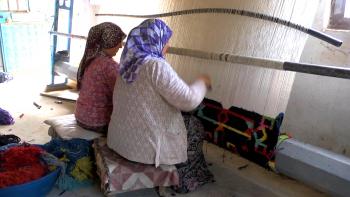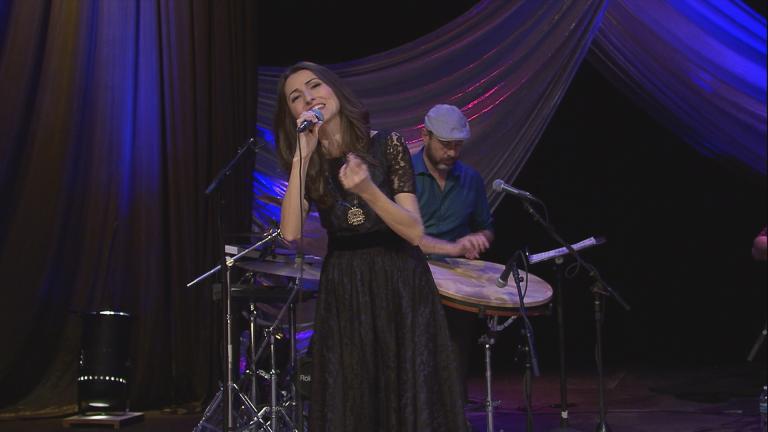
In Usak, the rug capital of Turkey, worn and discarded carpets will be reincarnated.
Buraq Adogan is the owner of Knotisse, an Istanbul-based wholesale carpet company that produces modern Turkish carpets & kilims. Adogan and his team collect thousands of old rugs and kilims from all over Turkey.
“We stock them here and then we categorize them, the ones in good condition and the damaged ones,” said Adogan.
The good ones begin the process of what Adogan calls “upcycling,” which involves taking the vintage carpets and kilims and repurposing them for what will eventually become new, modern rugs.
“The material in these vintage kilims, they are a very good quality. They are all made in between 1950s and 1980s, and all of them, they were made by hand,” Adogan said. “The yarn is spun by hand, and today it is very difficult to find this handspun material, and the effect in the kilim is much different than today’s material, so we prefer to use this material.”
The carpets are first loaded into a large wooden drum. As the drum spins, the decades of dirt and dust particles are purged from deep within the pile of the rug. Next they are soaked in a mild detergent, washed, scrubbed and spin-dried.
After they have dried, some of the newer carpets are sheared to even the pile before eventually being re-dyed.
“We are changing the form into a more valuable look, and that’s why I call them upcycling,” Adogan said.
There is a different process for recycling the old kilims, which were handwoven using a flat weave style. First they must be unraveled by hand. Adogan sends them to small villages in the foothills of Turkey, not far from Usak, to be dismantled.
Back at the warehouse, in a small corner room at the rear of the facility, a chemist mixes together cocktails of natural dyes to create the palette for Adogan’s modern motifs. The high quality yarn is then hung outside and dried.
Once the unraveled material from the vintage kilims is reprocessed, it is brought back to the villages where weavers begin the process of creating new world designs from old world quality.
Weaving kilims is a skill that has been passed on for generations in the small village of Manisa. But the traditional weavers were initially baffled by Adogan’s bold take on time-honored Turkish design.
“They were very surprised. We brought them new designs and new colors,” he said. “I mean, they were not used to using pink in a kilim, but in our funky pieces, we like to use some flashy colors. And first they said, ‘No, it is not possible to make this kilim with this color.’”
But eventually they came around.
Leyla Girgin has been weaving kilims for nearly 30 years. She says she appreciates the new flair and the unconventional designs, but not just for the aesthetics.
“These designs are easier to weave than the traditional ones, and so we were able to make them with no problems,” said Girgin.
The new carpets have shipped across the world, and have even arrived here in Chicago.
Brian Rojanasumaphong is a sales manager and carpet buyer for Oscar Isberian Rugs in Chicago's River North neighborhood.
“It’s beautiful. Yeah, it’s fantastic,” he said.
His responsibilities include identifying the hottest trends in rug design for his customers. He says many of those designs come from Turkey.
“Turkey is a place, that people in the rug industry, they really look forward to going to because they do such interesting, unusual things,” said Rojanasumaphong.
He says Knotisse is doing cutting edge work by mixing traditional materials with contemporary design.
“So this is a really interesting texture,” he said. “We have in the background, it’s like a kilim weave so it’s a flat-weave rug, woven kind of how a piece of fabric would be woven, without pile. And this is black goat hair cotton and wool all twisted together, so you get this kind of feathering effect.”
Rojanasumaphong also says the upcycled Turkish rugs are not only popular here because of their flashy style and quality materials, but also because of their eco-friendly origins.
“There's a sense of it being green, I think you know, as a people we are very aware of how much we consume every day, and the idea of repurposing anything in our lives, or anything that was once old that we can sort of reuse in a new way, I think that we find really compelling,” he said.
Adogan says, for him, it’s important to keep the tradition of Turkish carpet-weaving alive. And the idea that this otherwise discarded material is finding new life in his modern designs is exciting.
“I love it actually. I remember, I see my piece in a magazine or in a beautiful house, I feel really good, and when people like my designs or they enjoy our products, it makes me happy,” he said.








